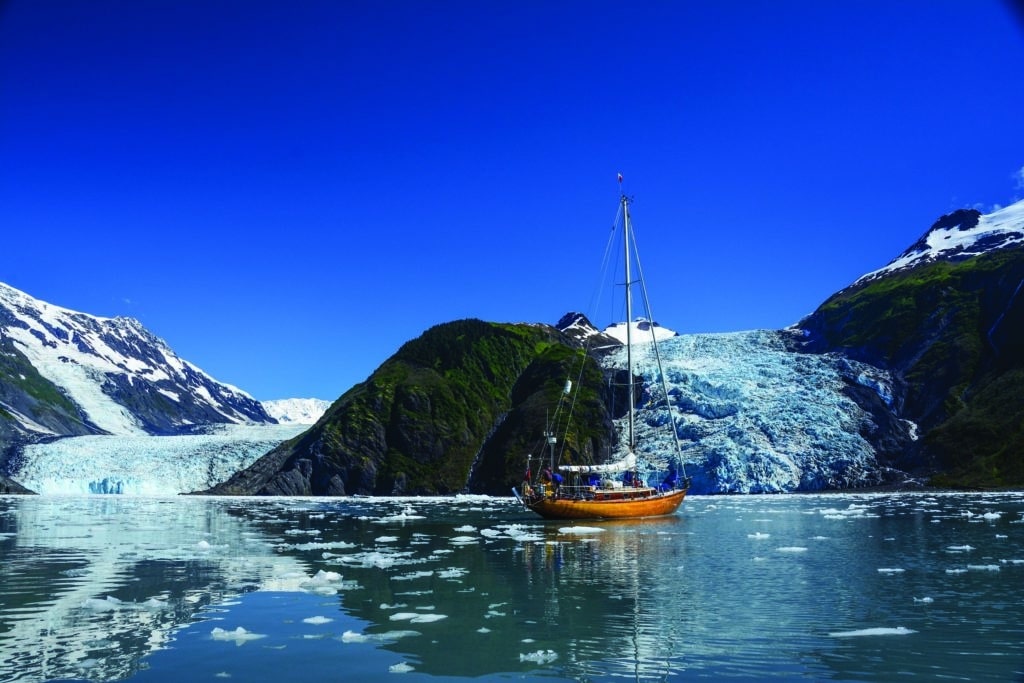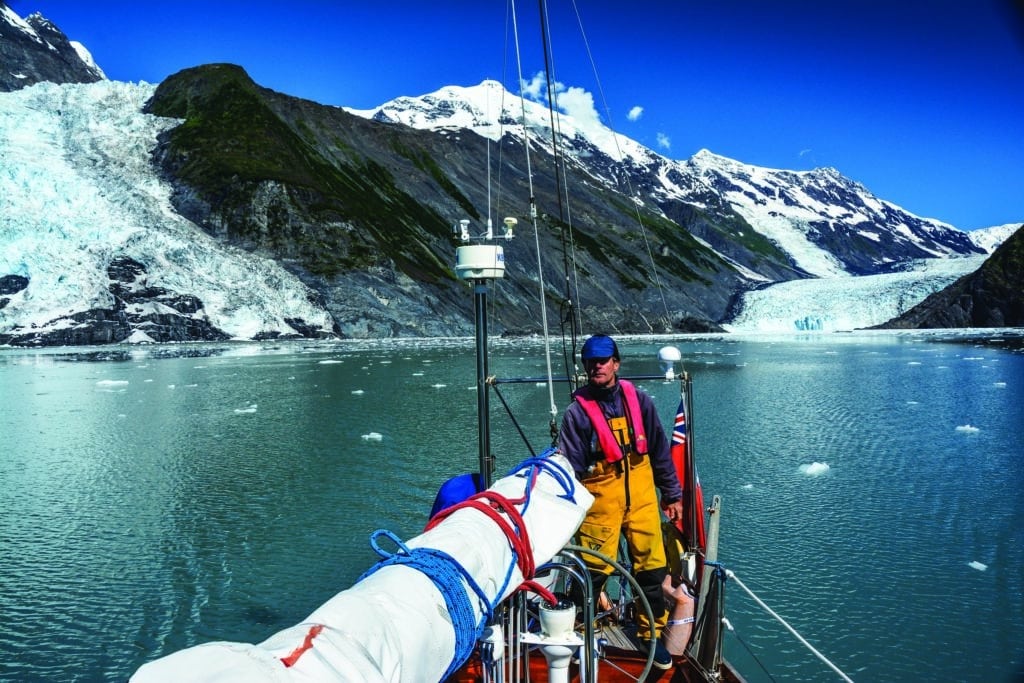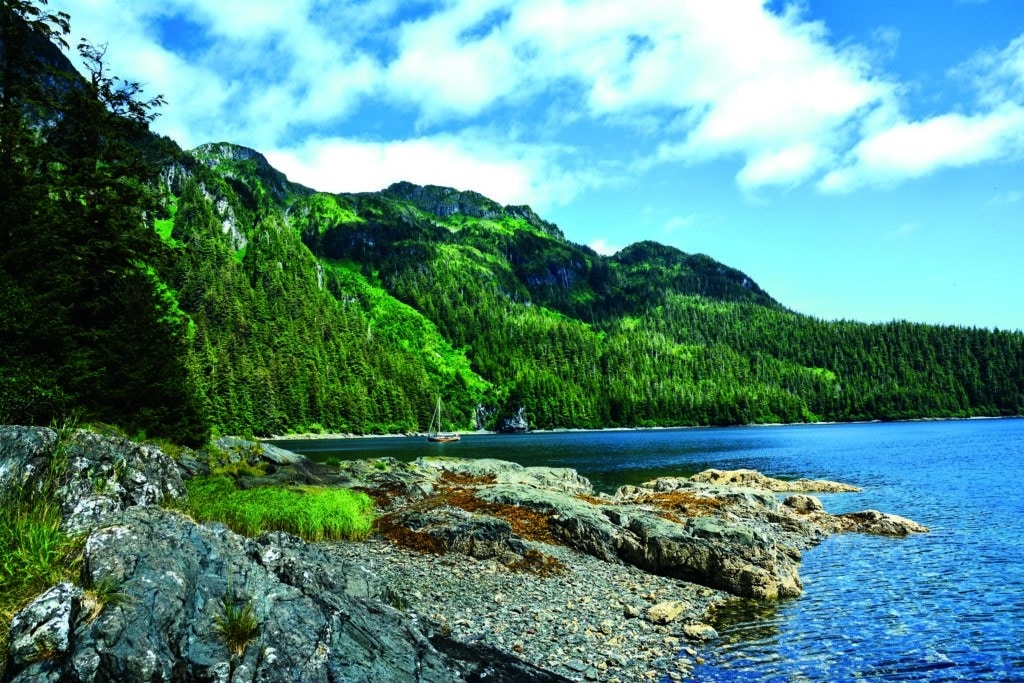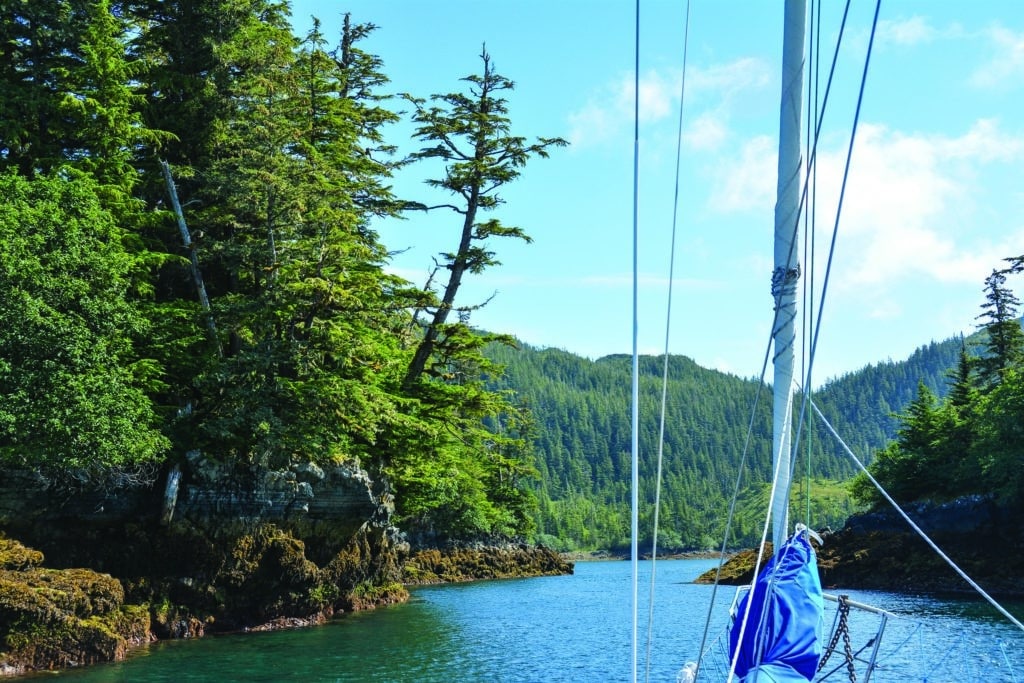
Of Otter Cove, in the Bainbridge Passage approach to Prince William Sound, our cruising guide said there would be “harbor seals, sea otters, black bears, gulls and bald eagles. Humpback and killer whales can also sometimes be seen.”
“Can it possibly live up to that billing?” we wondered.
Yet it did. Harbor seals and sea otters greeted us as we wove our way through the rocky entrance aboard Sunstone, our 40-foot Sparkman & Stephens–designed sloop, and eagles soared over the masthead. “There’s a black bear on the beach,” my wife, Vicky, announced. The only missing attractions were the orcas, though we saw humpbacks feeding the next morning shortly after leaving the cove. Prince William Sound on the Gulf of Alaska coast is like that.
For most cruisers, the gateway to the sound is Seward, Alaska, some 30 miles to the west, perched at the top of Resurrection Bay among snowcapped mountains and glaciers. In the Seward Small Boat Harbor are the yachts of most of Alaska’s sailors. The state’s largest city, Anchorage, is only a two-hour drive away. Prince William Sound is the sailors’ playground, and local knowledge is easy to pick up as you walk the docks.
We timed our arrival in Seward so we could catch the annual Mount Marathon Race, which takes place on July 4. The race is an extreme-sports event that caters to the wilder spirits so often found among Alaskans. Mount Marathon is a 3,022-foot peak immediately behind the town. Its steep, wooded lower slopes are twined with narrow trails tangled with roots and bordered by thorny devil’s club. Halfway up, the slopes open and steepen, covered with scree, a surface on which a climber slides one foot back for every two upward. The race is to the summit and back by any route from the start in town. The fastest men make it to the top in about 33 to 40 minutes. They then scree-slide down and leap from rock to rock in about 10 to 15. The men’s record is 42 minutes, 55 seconds. Limbs are regularly broken. Amazingly, vacant spots in the race are auctioned every year for up to $2,400. The exuberance and wildness of Alaska are personified by the competitors and their event.

As we moved north into the sound proper, the place names became either literal or evocative of some story. In Whale Bay we saw humpbacks blowing and feeding along the shore. Crossing Icy Bay, there were indeed bergy bits drifting down from Tiger Glacier at the head of the bay. Jackpot Bay must have a story, but its secret is the narrow entrance to beautiful Seven Fathom Hole, a perfectly protected, landlocked anchorage.
Up Dangerous Passage is Ewan Bay, where at its head are a lagoon and skookumchuck, the Alaskan name for a reversing tidal waterfall or rapid. The tidal rise and fall can be as much as 15 feet, which can leave you very high and dry if you catch a shoal or rock at the top of the tide. Oftentimes you can spot playful river otters in these tidal waterfalls.
The summer weather in Prince William Sound is mixed: There are sparkling days and then heavy rain, particularly in the extreme east and west of the sound, near Whittier and Cordova. The winds are often light, so the motor gets a workout. This is true of Alaskan cruising in general.
The whole of the sound is above 60 degrees north, so it is no surprise that Prince William Sound is full of tidewater glaciers that calve directly into seawater. One of the most accessible glaciers is Nellie Juan. Just east of the lagoon created by Nellie Juan’s moraine is Nellie’s Rest, a one-boat hidey-hole. From the anchorage, the really intrepid — who have no fear of bears — can bush-bash to get close to the glacier on land. The less adventurous may choose to take the dink into the lagoon and, dodging the bergy bits, approach the glacier by water to hear it groan and watch it calve. As we sat and watched the ice slides, we hoped that the calving wouldn’t make a wave big enough to swamp the dinghy.
When first looking at a chart of the sound, you might think that it seems a limited cruising area, easily covered in a week or two. Truly, years of cruising here would be needed to explore all of its anchorages, as can be seen from Jim and Nancy Lethcoe’s wonderful Cruising Guide to Prince William Sound. Choosing where to go is a challenge, and many of the anchorages have intricate approaches through rocky channels. Our guide spoke casually of anchoring in 80 to 90 feet, and many of the anchorages have gravelly or rocky bottoms, sometimes with kelp. Cruising the sound is not for the anchor-challenged. However, the careful pilotage of narrow entrances to Surprise or North Granite bays is paid in full by the dramatic scenery inside, with mountains rising sharply from the water or forming amphitheaters around the bay.

On the northern side of the sound, College Fjord is lined with a number of glaciers with monikers from Ivy League and Seven Sisters universities, and the nearby, massive Columbia Glacier continues the naming pattern. With the warming trends of recent years, virtually all of these have receded significantly, and Columbia has moved dramatically. For us, the most accessible of the northern glaciers are in Barry Arm and Harriman Fjord. When we first visited in 2002, Barry, Cascade and Coxe glaciers all came together at the head of Barry Arm. On this visit in 2014, they were separated and farther back, but still approachable and impressive. We nudged our way in, avoiding the brash ice to approach and hear the groaning movements of the cracked and creviced blue ice. True to the glacier’s name, cascades of ice fell regularly from the steep face into the water below. Moving through the ice demands care in any but the very strongest of metal hulls. Even small pieces of brash ice can damage a wood hull like ours, or a fiberglass hull. Prolonged pushing through ice can carve up the waterline area significantly.
On Alaskan car license plates is the nickname the Last Frontier, and indeed, while surrounded by the wilderness of the sound, we thought the name was accurate. When moving from anchorage to anchorage, hours or even a whole day can pass without sight of another vessel, and those that we did see were mostly fishing boats. Amid the vast scenery of Alaska, even larger vessels such as the Alaska ferries and the occasional cruise ship appear as mere dots of color against the snowcapped mountains and blue-gray water.
In contrast to this colossal landscape was the sudden immediacy of our contact with the natural inhabitants of the sound. A sea otter backstroked idly past our bow, stared for a moment, and then turned back to open the mollusk on its chest, while a mother otter tended to a wide-eyed pup riding on her tummy. As we moved along Knight Island Passage, we were suddenly surrounded by flashing black-and-white shapes. A pod of Dall’s porpoises had come to play. Bright in the clear, dark water, they crisscrossed under and in front of the boat. They seemed much faster and even more agile than any dolphins we’ve seen.
Two very small towns mark the far western and eastern ends of the sound. Whittier to the west was originally built as an army base, and nearly all of its few hundred inhabitants live in a single condominium tower that rises incongruously against the glacier-capped peak behind the town. Whittier has become something of a tourist hub since cruise ships began to dock there. The town’s road connection to nearby Anchorage, Alaska’s biggest city, also makes it a convenient place for cruising sailors to change crew, reprovision or access parts for repairs.
In contrast, Cordova is isolated at the eastern end of the sound, and can only be accessed by water or air. Fishing is its lifeblood. The boat harbor is packed with fishing boats large and small, from big seiners to one-man gill-netters. Cordova is the closest port to the Copper River delta, to the east of Prince William Sound. The delta is a rich fishing ground, but also a dangerous one, and the men and women of Cordova who fish are a tough breed who push their luck in shoal waters open to the Gulf of Alaska and its volatile weather. The town has a strong cultural life of its own, and the few hardy cruisers we know who have wintered there praise the warm welcome they have had — to contrast with the howling winds and snowdrifts.
Unlike the glacier-strewn west and north shores of the sound, the eastern side is lower and greener, with bays that are less rock-encumbered. At the head of most bays are salmon streams. When a run is on and the tide is low, it’s tempting to try to walk across the stream on the backs of the thousands of salmon, which fill the stream like a wriggling carpet, struggling up through the shallow water to spawn on the gravel streambed.

Beartrap Bay in Port Gravina was a delight once we worked our way through the narrow, tree-lined gut leading to the anchorage at its head. Salmon were leaping all round the bay, and harbor seals were on patrol, lifting their pop-eyed heads to check us out between feedings. The stream at the end of the bay was full of huge dog salmon, a popular species for sport fishing, though they are known locally as food for Eskimo dog teams.
Between the mainland shores of the sound are its islands. For those who prefer not to dare the bears, a stop at West Twin Bay on Perry Island is a great opportunity for a hike. The island has no salmon stream and so has little to tempt bears to make the long swim to its shores. When hiking in Alaska we are mindful of being able to find our way back to the dink. There are two methods: The high-tech way is to carry a handheld GPS and put in waypoints as you go, then follow them back. For low-tech, we carry several white or yellow plastic bags and tie them to very visible bushes and trees along our route, retrieving them as we return.
Visiting tiny Disk Island, between Ingot Island and Knight Island, is a challenge. As we approached its very narrow entrance, we wondered if Sunstone’s shrouds would clear the overhanging trees as we wove through the rocks at the mouth. The depth shoaled and shoaled. A heavy branch clattered on the rigging. A little to starboard, and the depth increased. We were through, and into the almost perfectly circular, landlocked anchorage.
Knight Island is the mountainous jewel in the middle of the sound. All around its coast are anchorages, giving the possibility of shelter from any direction. The west arm of the Bay of Isles indents the northeast coast of Knight so deeply that it almost reaches the west coast. Deep in the arm we sat out some windy weather with barely a ripple. Our favorite Knight Island anchorage is in Snug Harbor, on the southeast coast. Tucked in at the head of the bay, we looked around at the waterfall on the steep cliff and up at the remains of winter snow on the peaks above. Two streams poured in at the head of the bay, one swirling with pink salmon, also known as humpies, which are the primary harvest for the big seiners. Also circling at the mouth of the stream, waiting their turn to go up, were schools of silvers, the higher-value coho salmon. The origin of their nickname was evident in the light flashing off their backs.
Ashore at low tide, we walked up the gravel bank of the stream. We spotted a sleek black bear a hundred yards away, fishing in a pool. Though smaller, the black bears are somehow more elegant than the bigger brown bears we’ve seen. This one sidled back and forth across the shallow pool, then leapt down with a huge splash, stunning a fish and grabbing it in his teeth. At the bank he threw it down, inspected it and rejected it back to the pool. Three times he did this. Finally he pounced, grabbed a fish and contentedly lumbered through the grassy sedges and into the trees. We guessed that he was so well fed that he could afford to be choosy.
All the best things come at a price. Prince William Sound is a beautiful wilderness set in the magnificent backdrop of Alaskan scenery. It’s a long way from almost anywhere else, and an area of volatile weather. We sailed 7,000 miles from New Zealand to get there for the second time, and it was worth every mile and every day of the journey.
Tom and Vicky Jackson have lived aboard, cruised and raced Sunstone 180,000 miles since 1981. Most recently they have completed a circuit of the Pacific Ocean from New Zealand to Japan and the Aleutians, followed by the Round New Zealand Two-Handed Race. They are now back cruising in Alaska and British Columbia for the third time. When not out voyaging on Sunstone, they are now based in Nelson, New Zealand.
Click here for more resources about cruising Prince William Sound.








